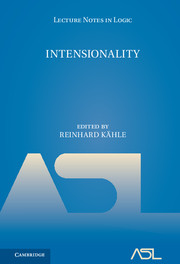Book contents
- Frontmatter
- Preface
- Contents
- The modal aether
- Possible worlds semantics for predicates
- A context principle
- The semantics of modal predicate logic II. Modal individuals revisited
- Intensionality and coercion
- Intensionality in philosophy andmetamathematics
- Representation theorem for models of dynamic intensional logic
- Intension, intention
- Modality, mood, and descriptions
- Coercion vs. indeterminacy in opaque verbs
- References
Intensionality in philosophy andmetamathematics
Published online by Cambridge University Press: 30 March 2017
- Frontmatter
- Preface
- Contents
- The modal aether
- Possible worlds semantics for predicates
- A context principle
- The semantics of modal predicate logic II. Modal individuals revisited
- Intensionality and coercion
- Intensionality in philosophy andmetamathematics
- Representation theorem for models of dynamic intensional logic
- Intension, intention
- Modality, mood, and descriptions
- Coercion vs. indeterminacy in opaque verbs
- References
Summary
Abstract. The relation between intensionality as understood in philosophy and in metamathematics (in particular in early writings of S. Feferman) is explored in this paper. It investigates whether the latter can be interpreted as an instance of the former and presents metamathematical examples of “serious intensionality”.
Truth and reference (i.e., extensions) on the one side and meaning (i.e., intensions) on the other side are closely related: for example, principles like every true sentence is meaningful and expressions with the same meaning refer to the same things (if they refer) seem to be correct from an intuitive point of view. Of course, this does not mean that, e.g., truth or falsity are the meanings of (declarative) sentences. Nonetheless, were it not because of contexts taken from ordinary language — like those containing modalities and propositional attitudes — expressions like “meaning” could perhaps be explained by employing terminology taken solely from referential semantics. Thus, it has been claimed that for scientific purposes one may well get on with purely extensional languages.1 In fact, this seems to be “obviously” true for the mathematical discourse.
It is mainly due to the work of S. Feferman that the topic of intensionality has nevertheless gained some relevance, perhaps even popularity, in the field of metamathematics (cf. primarily [12]). But what is the relation between “intensionality” as understood in philosophy and as understood in metamathematics? Are these two concepts actually the same? If not, is it at least possible to make them fruitful for each other, e.g., by construing one of them as a special case of the other? This paper addresses these questions both from a conceptual perspective and by presenting relevant metamathematical results.
Intensionality in philosophy: an overview.
Intensionality: basic phrases. When dealing with intensionality, a natural starting point is G. Frege's distinction (see his seminal [16]) between “Bedeutung” (i.e., reference) and “Sinn” (i.e., meaning): expressions s, t may refer to the same entity while, at the same time, presenting that entity in different ways — whence s and t have different meanings.
Information
- Type
- Chapter
- Information
- Intensionality , pp. 123 - 159Publisher: Cambridge University PressPrint publication year: 2005
